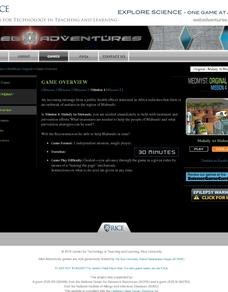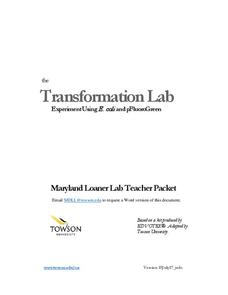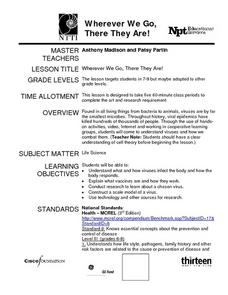Center for Technology in Teaching and Learning
MedMyst Mission 3: Nemesis at Neuropolis
Calling all science sleuths! A patient appears to have a disease eradicated years ago—how do you treat it? Scholars must research the illness, the possible causes, and find a cure before the disease spreads and wipes out the entire city....
Center for Technology in Teaching and Learning
MedMyst Mission 1: Orientation at O.R.B.
A dozen years after a great plague wipes out the majority of Earth's civilization, a group of scientists joins together to fight infectious diseases. Scholars join the training mission and learn about viruses, bacteria, pathogens and...
Centers for Disease Control and Prevention
Poisoned Picnic
A group of teachers attended a picnic; ten became sick and another four died. Young scholars must solve the mystery of what happened. They research the river, waste water treatment plant, each food that was served, and environmental...
Baylor College
Infectious Disease Case Study
Small groups of life science learners look at Allison's symptoms and discuss a diagnosis. They use a chart of illnesses and draw symptom clues from an envelope to determine what illness she has. A lesson like this gives children an...
Curated OER
Regents High School Examination: Living Environment 2010
This exam touches upon every topic within the typical first year biology course.. A broad variety of question styles give high schoolers every opportunity to show what they know. Why start from scratch when a comprehensive final exam is...
Smithsonian Institution
Vaccines! How Can We Use Science to Help Our Community Make Decisions about Vaccines?
Uncover the fascinating world of vaccines in a multifaceted activity. Investigators explore community perception and the science of vaccines with eight tasks. Scientists continue their studies by giving and reviewing surveys, analyzing...
Exploratorium
Antibody Attack - Discover How Antibodies Launch Attacks on Invaders
Jump into the action and help antibodies defend against an antigen attack! Investigators match antibodies with antigens to model the body's identification and recall of specific pathogens. Young biologists also recognize that each...
Exploratorium
Skin Shield - Explore the Body’s First Line of Defense Against Pathogens
Make pathogens and the body's defense systems come alive for young biologists in a hands-on activity. Investigators model the skin's protection against infection by observing and comparing changes in a punctured tomato and an intact...
Children’s Hospital of Philadelphia
The Innate Immune System
My body is my castle. Pupils learn about the innate immune system in the second lesson plan of a three-part unit on the immune system by comparing the innate immune system to a castle and moat. Groups conduct a simulation where they try...
Children’s Hospital of Philadelphia
Discovery and Development of Vaccines
Stop the spread. Pupils work through two activities to gain an understanding of vaccines and immunity. Learners research different types of vaccines and how they are made and explore the advantages and disadvantages of them. Using a...
Children’s Hospital of Philadelphia
Development of Disease and Infection
It's all in the cards. Using cards to simulate a disease's attack on the immune system, pupils develop an understanding of how the immune system and pathogens react to each other and why at times the pathogen wins. Groups play a game to...
Children’s Hospital of Philadelphia
Understanding How Diseases Spread
To boost disease prevention, high schoolers arm themselves with information about infectious diseases and how they spread. Scholars research the causes, prevention techniques, and identify high-risk groups especially vulnerable to a...
Center for Technology in Teaching and Learning
MedMyst Mission 4: Malady In Mabuufo
An outbreak of malaria requires your help to stop its spread. To discover the pathogen that causes malaria and multiple ways to fight the illness scholars play games, answer short quizzes, and learn scientific concepts with the fourth...
Center for Technology in Teaching and Learning
MedMyst: Animal Alert!
An outbreak of disease is affecting people in a distant region—it's time to get to work! Scholars take the role of scientists as they learn more about the illness, discover the possible causes, and find a way to prevent the further...
Howard Hughes Medical Institute
Cells of the Immune System
You won't be able to resist the content of a great presentation! Young immunologists discover the variety of cells involved in keeping our bodies free from pathogens with a resource that contains both slides and video clips. The included...
Concord Consortium
3D Exploration of Bound Antibody and Antigen
Our body manufactures antibodies that are the exact shape for the antigens it encounters. The simulation shows a 3-D model of an antibody and antigen pairing. It allows young scientists to explore the complementary shapes.
Towson University
Transformation Lab
Transform your class' understanding of genes and antibiotic resistance with the Transformation Lab. Junior geneticists create and observe their own resistant strains of E. coli through research, discussion, and experimentation. The...
Virginia Department of Education
The Germ Theory and Koch’s Postulates
Explore the history of cholera and its effect on society with your biology class. Young biologists will then proceed to grow their own germs, prepared from live cultures, and follow the steps of the scientific method to generate data....
Smarter Balanced
Communicable Diseases
Pathogens, what they are, how they spread, and how to prevent them from spreading are the focus of this resource that can be used to prepare learners for a performance task assessment or to begin the study of communicable diseases.
Curated OER
Changing Planet: Infectious Diseases Classroom Activity
Here is a different approach: emerging epidemiologists first go home to interview family on the topic of infectious disease. Then they come to class and view a video and PowerPoint that explore how climate change may increase the...
Curated OER
Wherever We Go, There They Are!
The central video for this lesson is not available through the included resource link. However, the activity that simulates the passing of a virus through a population is impacting and the other resource links are invaluable. Use this...
Children’s Hospital of Philadelphia
Case Studies: Influenza and HIV
Stop infection spread. Pupils participate in an activity to model infections and replications of viruses. Within the activity, scholars see that viruses may end up with genetic variation and connect that to how some forms of the flu are...
Curated OER
Illness and Prevention
Fourth graders set personal health goals for preventing illness, identify different pathogens and explain how the body protects itself from pathogens, discuss ways in which prevention and transmission of disease are affected by...
Curated OER
Food Safety-Consumers Need the Facts
High schoolers begin by completing a survey asking them to rank their concerns about commercially prepared foods. They develop a definition of relative risk, and complete the "Pro or Con" worksheet. Students work in groups to make a...

























